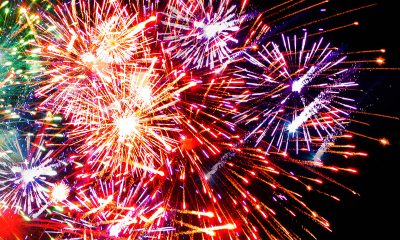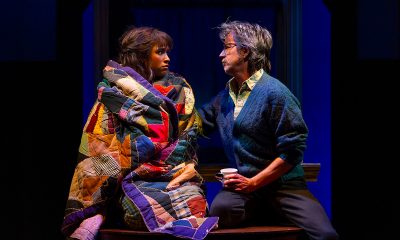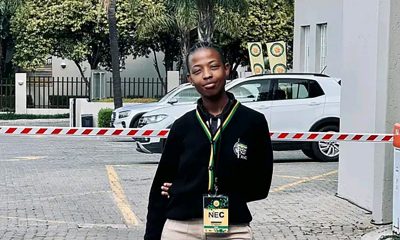Opinions
Activism, the black athlete and supporting LGBT equality
Ali’s legacy and why Kaepernick’s critics are wrong
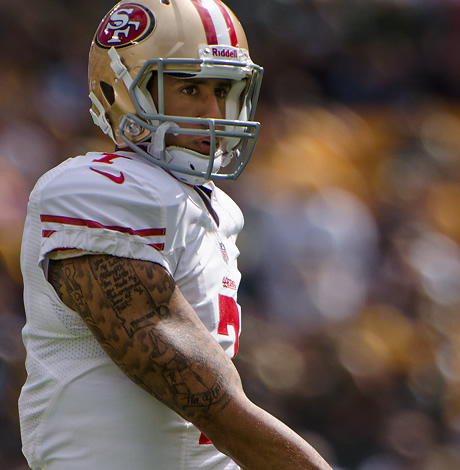
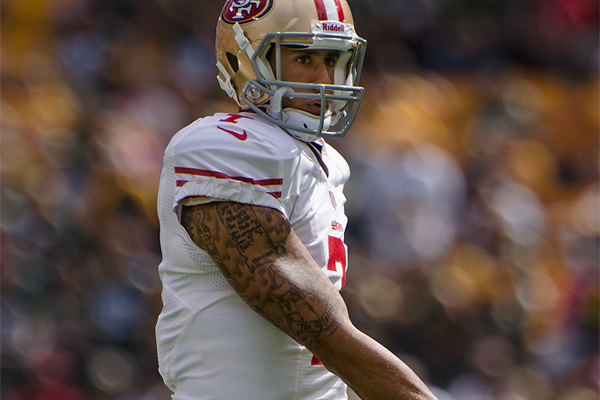
Why do we praise Muhammad Ali, yet criticize Colin Kaepernick? (Photo by Mike Morbeck; courtesy Flickr)
Why do so many African-American professional athletes today view Muhammad Ali as a hero, but fall short of even trying to live by the same code of ethics that made him a hero? Ali became a hero because he was never silent. He said things he knew would make people uncomfortable, even angry, but that he believed would help bring about awareness and change. Ali was, as a result, a controversial figure during his life. He angered countless people with his message and many people hated him. It was only later that Ali was recognized for his impact on our country.
I remember that once as a boy I heard Ali call himself “pretty” on TV. This was before Beyoncé made big booties sexy, before girls were pumping their lips full of fillers. This was the 1970s. “Black” features were not considered pretty. I remember how powerful it was to see a man who looked like me categorize himself that way. I was nine years old, and I have never forgotten that moment. It was a small moment, but one that empowered me to feel good about myself. That is the power we possess as professional athletes: We have a platform to speak, and a way to give voice to so many voices that remain unheard. We have the ability, and I believe, the responsibility, to serve as a voice that will empower and engage others. But that platform, and the power it gives us, is an opportunity too many of us ignore.
When I started writing this piece, my intention was to draw attention to Black athletes who admire Ali for his activism, but remain silent as injustices continue to reveal the persistent inequity in this country. More specifically, I wanted to center that discussion on the fact that African-American heterosexual males have remained noticeably absent in the fight for equal rights for the LGBTQ community, being that we are all too familiar with what it feels like to be a disenfranchised and discriminated against minority. Before I finished the piece, however, I saw San Francisco 49ers quarterback Colin Kaepernick sit down for the national anthem — and I saw America stand up in protest. When asked why he didn’t stand, Kaepernick said he was “not going to stand up to show pride in a flag for a country that oppresses Black people and people of color.”
The way Kaepernick took a stand was exactly the type of activism I wanted to see among today’s Black athletes, but before I had time to applaud him, the media crucified him. Worse yet, it wasn’t just the mainstream media that was speaking out. Even fellow Black athletes were speaking out against him. It was bad enough that so many Black athletes were willing to be silent and let others stand up for our people, but now some were actually chastising him for standing up for us. Kaepernick wanted dialogue, but instead he got told that he had crossed a line. He wanted to spark conversation, but instead he was told to be quiet. In fact, he was told to be grateful.
Ironically, one of the criticisms of Kaepernick came in the form of an argument that Kaepernick was not in a position to stand up for Black people because he was not Black. Forgetting about the fact that Kaepernick is in fact half Black, that position itself is nonsensical. If he were white, would it be wrong for him to stand up for Black people? Does that mean that white people cannot defend the rights of Blacks or other minority groups? That straight people cannot defend the rights of the LGBTQ community? Historically, no minority group has ever gained the equal rights they sought without the support of the majority.
And it’s true that Kaepernick does not necessarily feel the impact of racism or injustice day to day ⎯ he is not part of the disenfranchised Black community he is fighting to protect. The Civil Rights leaders of the 1950s, such as Martin Luther King Jr. and Malcolm X, were standing up for their own rights along with the rights of the Black community ⎯ King couldn’t sit at the front of the bus either. Kaepernick is educated, and has a multi-million dollar contract as a quarterback in the NFL. But in my mind that makes his action even more powerful, not less. His silent protest was not driven by self-interest. He chose to speak for those who don’t have a voice. As he put it, “This country stands for freedom, liberty, justice for all ⎯ and it’s not happening for all right now.” That was reason enough for him to take action, despite any repercussion he might face. That is what makes him a leader.
So why are so few athletes willing to stand up — or, in Kaepernick’s case, sit down? Many people do not realize that if a player has made it to the NFL, he has been playing since he was a child. From that time, he has been systematically trained to aspire to be in the NFL. Once a player makes it to the league, his impulse is, one, to fall in line, to do nothing that might jeopardize his team, a sacred brotherhood. Two, not to do anything to jeopardize his salary or endorsements. More than half of the players in the NFL come from poverty. For more than half the players in the league, football is the only way they see to take care of themselves and their families.
But the impulse and pressure to fall in line is what keeps so many players from standing up the way Kaepernick has — and keeps so many players silent when they could be voices of change. The unfortunate truth is that their fears are not unfounded. Broncos linebacker Brandon Marshall, who has chosen to take a knee for the anthem in light of Kaepernick’s protest, has already lost two endorsements as a result of his actions. While too many of us still sit on the sidelines in the fight for justice, I am heartened that Kaepernick’s activism has begun to gain momentum: more athletes take a knee, raise their firsts, link arms in support of him and his message. Even 49ers owner Jed York came out in full support of Kaepernick. Despite sacrificing two endorsements, Marshall remains steadfast in his commitment to the protest, and the conversation he hopes it will inspire.
I would love to see this momentum continue to build and have more professional Black athletes stand up publically for the larger Black community. But what I would also love to see is that activism stretch beyond the reach of our own people and begin to try to help yet another marginalized group, the LGBTQ community.
There is an unmistakable power balance in this country, and we all know who wields that power. That being said, within the other groups that comprise our nation, there does exist a hierarchy of power. That hierarchy is what gave Kaepernick the opportunity to stand up for his beliefs in a way that a lot of other Black men never could. It is also what allowed the entire football team and the entire student body at University of Missouri to stand up for Michael Sam, and allow him to live his life openly as a gay man (which, by the way allowed him to play the best season of his entire collegiate career). And, two years later allowed the Missouri football team to stand together as a team against the racial discrimination that was occurring on their campus and boycott playing a single game until they got a public apology from the president of the university. Regardless of our race, as athletes, we do in fact wield power. The power to raise our voices for change is in our hands, but I see so much silence.
The LGBTQ community is another minority community in our country that is still fighting to be truly equal under the laws of our nation. And while I am by no means saying that the Black fight for equality is over, what I am saying is that there are many Black people in this country, such as professional athletes, that do in fact have a tremendous platform with which they can show support for the LBGTQ community. We have power to not only help ourselves, but to help another group who seeks fairness and equity.
If more professional athletes stood up for the LGBTQ community the same way Muhammad Ali and Colin Kaepernick did and the way others are beginning to do, think of the impact and the power that would have on the LGBTQ community and their fight for equality. Think about what would happen if two of my favorite athletes ⎯ Michael Jordan and LeBron James — went to Nike and said they wanted to film a PSA because they had a family member or close friend who is gay and wanted to publicly show their support. Because let’s face it, we all have at least one family member or close friend that is a part of the LGBTQ community. But instead we allow ourselves to be told by the corporations what we can and cannot do. Why can’t we realize that we have just as much if not more power than the students at University of Missouri? If we stand together on the right side of history, then the power is ours. We need to be on the front line of history, not wait until it is cool to be in support of something that is not allowing friends and family members to feel safe and live their life to fullest.
In our community there is still a widespread fear that being an advocate for, or even just an ally of the LGBTQ community will call into question our own sexuality or masculinity as straight Black men. The base level of this fear is straight forward (albeit based on a false assumption) that supporting the LGBTQ community will lead people to think that we are gay or less of a man. As a result, many of us would rather say nothing than do something that would lead others to have that perception of us. There is also a financial fear associated with being a straight ally. That fear being that if people think that we are homosexual or an ally to the LGBTQ community, it will have a detrimental effect our brand, and in turn, our wallet.
I also want to address the argument that religious people cannot support the LGBTQ community due to the teachings of the Bible. First of all, I would like to remind all of my Black brothers and sisters that it was not too long ago that people used verses from the Bible to back up arguments to keep slavery legal. We, as African Americans cannot in good faith use the same teachings that were used to oppress us to suppress the rights of another group of people. Second, I would love someone to tell me when the laws in the Bible got ranked. In other words, what divine power came down and told us that the teachings that prohibit homosexuality are more important than the teachings that tell us to “love your neighbor as yourself?”
We must begin to the dispel the ideas held by so many straight Black men that being an ally to the LGBTQ community will hurt them in some way. In order to do this, there are two major revelations to which these athletes must come. The first is that the stereotypes they grew up hearing are antiquated and untrue. We must all be a part of eliminating these stereotypes, and we can do that simply by letting our words and our actions defy them. The second is that becoming a straight ally for the LGBTQ community will actually broaden their brand and appeal. The LGBTQ community accounts for more than $9 billion of buying power in this country. When Michael Sam came out as a gay man, his jersey shot straight to the No. 2 most purchased NFL jersey in the country. When Steve Jobs died, Tim Cook took over as CEO of Apple, and has subsequently come out as a gay man. We all still walk around with our iPhones tight in our clutches, but how many of us stop to think about the fact that the company that makes them — one of the most powerful companies in the country — is run by an openly gay man?
Muhammad Ali has, in the wake of his death, been mourned and celebrated in the media as an athlete who transcended sport and became an icon of activism and social justice. However, the same people who praise Ali for his activism and commitment to social justice can, almost in the same breath, condemn Colin Kaepernick for attempting to use his platform as an athlete to do the same. Ali paved the way for athletes like Kaepernick to speak out. If we celebrate Ali for creating the path, then how can we disapprove of athletes like Kaepernick for walking it?
It is time Black athletes realize our power and responsibility to bring change in America — and it is time for America to stop fearing what the change will look like. We must say and do the things that will spark conversation about important issues that we face because conversation is the first step toward resolution.
If we cannot speak about the issues, how can we hope to resolve them? More specifically, we, as heterosexual Black men with a voice need to get on the right side of history in the fight for LGBTQ equality. It is our responsibility to stand up for the underdog, the discriminated against, because we have been and still are discriminated against. We must stand up for communities other than our own just as we want others to stand up for us. We must be upstanders and not bystanders, we must stand up and use our voice for change, acknowledging that no group of human beings deserves to be treated as inferior.
We must applaud Kaeperrnick for his actions by acknowledging that great leaders have the strength and conviction to never mistake the easy choice for the right one. But applauding him is not enough. We must accept that once we identify a great leader such as him, we must have enough of our own strength and conviction to follow him.
Sean James is executive director of Sports & Entertainment for Hotaling Group Insurance Services and a former NFL player.
Opinions
USAID’s demise: America’s global betrayal of trust with LGBTQ people
Trump-Vance administration dismantled agency after taking office

The U.S. Agency for International Development — proudly my institutional home for several years of my international development career and an American institutional global fixture since November 1961 — is no more.
How will USAID’s closure impact LGBTQI+ people around the world, especially in poor, struggling countries (“the Global South”)? Time will tell, but “dire,” “appalling,” and “shameful” are appropriate adjectives, given the massive increase in HIV/AIDS deaths that follow the callous, abrupt, and unspeakably cruel cut-off of funding for USAID’s health and humanitarian programming in HIV/AIDS prevention, treatment, and care.
Regarding LGBTQI+ people and issues, USAID worked in a tough neighborhood. In Africa alone, more than 30 countries in which USAID had programming still criminalize same-sex relationships, often to the point of imposing the death penalty. These fiercely anti-LGBTQI+ countries share harsh anti-LGBTQI+ punishments with most countries in the Middle East and North Africa. Other countries where USAID formerly worked retain colonial-era sodomy laws.
Where did USAID fit into all this turbulence? The agency was not allowed to transgress local laws, so how could it support the human rights of local LGBTQI+ people? USAID did so by building close and trusting relationships with local LGBTQI+ civil society, and by “superpower advocacy” for the universal human rights of all people, including those of us in the queer community.
I served at USAID’s Africa Bureau under the Obama administration, becoming the only openly transgender political appointee in USAID’s history. In that role, I was privileged to have a platform that caught the astounded attention of both queer people and of anti-LGBTQI+ governments around the world. If the president of the United States can elevate a transgender woman to such a senior position within the U.S. government, that open declaration of acceptance, inclusion, worth, and recognition set a precedent that many in the LGBTQI+ community worldwide hoped their countries would emulate.
Serving as an openly queer person at USAID also afforded me the opportunity to meet with many fiercely anti-LGBTQI+ senior politicians and government officials from African countries who sought USAID funding. Uganda’s first woman speaker of the parliament, Rebecca Alitwala Kadaga and her whole delegation came to see me at USAID in Washington about such funding. I had some very frank (and USAID-approved) “talking points” to share with her and her team about President Obama’s strong and secular commitment to equal human rights for all people. My tense meeting with her was also an opportunity to educate her as to the nature of the transgender, nonbinary, and intersex community — we who are simply classified and discriminated against as “gay” people in Uganda and in most countries in the Global South. I also had the chance to represent USAID in the “inter-agency” LGBTQI+ human rights task team led by openly gay U.S. Ambassador David Pressman, whose effective leadership of that Obama-era initiative was inspirational.
Working closely with professional, capable, and caring USAID career employees such as Ajit Joshi and Anthony Cotton, and with the strong and open support of the USAID Deputy Administrator Don Steinberg, I helped to craft and promote USAID’s very first LGBTQI+ policy. Under President Obama, USAID also created the LGBT Global Development Partnership, a public-private partnership supporting LGBTQI+ civil society groups throughout the Global South. USAID funding also increased for programs promoting LGBTQI+ inclusion, anti-violence, and relevant human rights protections. This programming expanded further (albeit never adequately funded) during the Biden administration under the able leadership of USAID Senior LGBTQI+ Coordinator Jay Gilliam and his team.
So what did it all mean? Has USAID left a footprint for the global LGBTQI+ community? Will its absence matter?
In my view, that answer is an emphatic yes. International development and humanitarian response go to the heart of recognizing, respecting, and caring about universal human dignity. USAID converted those ethical commitments into tangible and meaningful action, again and again, and modelled for the world what it means to truly include all persons.
My time serving at USAID was a high point of my career, being surrounded by the best of American civil servants and foreign service officers. For me, “USAID Forever” remains my battle cry. Let’s start thinking of how we will rebuild it, beginning in three years.
Chloe Schwenke is a professor at Georgetown University’s McCourt School of Public Policy.
Opinions
Community comes together to repair WorldPride history exhibition
Vandals damaged pictures, timeline walls on June 22

Earlier this month, vandals shouting homophobic slurs damaged the 8-foot hero cubes and timeline walls of the Rainbow History Project’s (RHP) WorldPride exhibition “Pickets, Protests, and Parades: The History of Gay Pride in Washington.” The week’s incident was the fifth homophobic attack on the exhibition chronicling DC’s LGBTQ+ History, the vandalism damage was only made worse by the storms this past week.
In response, RHP posted a call online for volunteers and donations and over a dozen volunteers showed up on Saturday to repair the exhibition in its final stretch.
It took three hours, but the group assembled during a heat advisory to bend the fences back into place, fix the cubes and zip tie all the materials together to keep them safe. Some of those who came out to volunteer, Slatt said, were known RHP volunteers but most were total strangers who had attended an event here or there or just wanted to get involved for the first time, one was even in D.C. as an out-of-town guest and after seeing the Instagram call, decided to spend their day lifting some heavy fencing back into place.
When asked why they showed up, volunteer Abbey said: “especially during Pride month, it’s so important to come together as a community, not just to celebrate, but to support each other. To know that this historic exhibit is even able to exist right now under this administration is really amazing. The fact that we’re just able to help continue it in its last leg of being out here is really important.”
“Rainbow History Project does a lot of work for the community,” another volunteer Ellie said, “they show up in a lot of ways that I think we really need right now, so in terms of being asked to come out and do a couple hours of lifting, that is something that we can easily support and do.”
“We put out a call asking for support from the community, and so we didn’t know what we’d get,” Slatt continued, “but strangers have shown up. We were upset, we were crying. We were trying to come up with a battle plan and more and more people have shown up with open arms and empty hands to do this. It’s 95 degrees, we are melting in the heat. It’s just amazing the number of people who have come here.”
If anything, the anonymous exhibit designer said, the people who vandalized the exhibit made the community stronger and mobilized members passionate about preserving and sharing our histories. Their efforts backfired in a big way — bringing together people who had only attended one or two RHP events or had read about the organization online to actively contribute to the work.
It’s a meaningful representation of the history of D.C.’s LGBTQ+ community, one that often starts with a small group of people who come together to protest but soon mobilize their communities and enact monumental change in the nation’s capital.
“If Pride in D.C. started with 10 people picketing the White House,” Slatt remarked, “you just got 12 more to join the gay history movement.”
This was especially poignant, another volunteer Mattie said, on the week that the Supreme Court issued a decision allowing Tennessee to ban puberty blockers and hormone therapy for minors seeking gender affirming care. It was a devastating moment for the LGBTQ+ community who mobilized once more in front of the Supreme Court this past Friday.
“It’s been actually really important to see this community come together in the face of direct attack on our history in the wake of direct attacks on our rights,” Mattie said, “and we stand up to that. We come together, and we represent. That is so important to maintaining our strength and our community throughout trying times now and ahead.”
When asked about how community members can support RHP’s work and repair the damage long-term to the exhibit, Slatt urged people to donate to RHP, to volunteer as exhibit monitors, and to come visit the exhibit.
“We’ve been doing this for 25 years. This is our 25th anniversary, and if it weren’t for volunteers donating their time and their talents, if it weren’t for small dollar donors, we would never have gotten anything done,” Slatt said. “I’d say to anyone out there that we are on this plaza all through Independence weekend, we are here through the Smithsonian Folklife Festival, people can come on down.”
Slatt and other volunteers will be leading tours each evening at 7 p.m. at Freedom Plaza, and people can pre-order the exhibition catalog right now, which will be delivered in time for LGBTQ+ History Month in October.
Emma Cieslik is a D.C.-based museum worker and public historian.

Independence Day, commonly known as the Fourth of July, is a federal holiday commemorating the ratification of the Declaration of Independence by the Second Continental Congress on July 4, 1776, establishing the United States of America. The delegates of the Second Continental Congress declared the 13 colonies are no longer subject (and subordinate) to the monarch of Britain, King George III and were now united, free, and independent states. The Congress voted to approve independence by passing the Lee resolution on July 2, and adopted the Declaration of Independence two days later, on July 4.
Today we have a felon in the White House, who wants to be a king, and doesn’t know what the Declaration of Independence means. Each day we see more erosion of what our country has fought to stand for over the years. We began with a country run by white men, where slavery was accepted, and where women weren’t included in our constitution, or allowed to vote. We have come far, and next year will celebrate 250 years. Slowly, but surely, we have moved forward. That is until Nov. 5, 2024, when the nation elected the felon who now sits in the Oval Office.
There are some who say they didn’t know what he would do when they voted for him. They are the ones who were either fooled, believing his lies, or just weren’t smart enough to read the blueprint which laid out what he would do, Project 2025. It is there for everyone to see. There should be no surprise at what he is doing to the country, and the world. Last Friday his Supreme Court, and yes, it is his, the three people he had confirmed in his first term, gave him permission to be the king he wants to be. The kind of king our Declaration of Independence said we were renouncing. A man who with the stroke of a pen can ruin thousands of lives, and change the course of America’s future. A man who has set back our country by decades, in just a few months.
So, I understand why many are suggesting there is nothing to celebrate this Fourth of July. How do we have parties, and fireworks, celebrating the 249th year of our independence when so many are being sidelined and harmed by the felon and his MAGA sycophants in the Congress, and on the Supreme Court. Yes, there are those celebrating all he is doing. Those who want to pretend transgender people don’t exist, and put their lives in danger; those who think it’s alright to take away a women’s right to control her body, and her healthcare; those who think parents should be able to interfere on a daily basis with their children’s schooling and wipe out the existence of gay people for them. Those who pretend there was a mandate in the last election, when it was only won by about 1 percent. Those who think disparaging veterans, firing them, and taking away their healthcare, is ok. Those in the LGBTQ community like Log Cabin Republicans, who think supporting a racist, sexist, homophobe is the right thing to do.
So, what do we, as decent caring people, do this Fourth of July. What do we say to those who are being harmed as we celebrate. What do we say to those trans people, those women, those immigrants who came here to escape their own dictators, and are now finding they have come to a country with its own would-be dictator. I say to them, please don’t give up on America. Don’t give up on the possibility decent loving people in our country will finally wake up and say, “enough.” That the majority of Americans will remember we fought a revolution to escape a king, and we fought a civil war to end slavery. That we moved forward and gave women the right to vote, and gave the LGBTQ community the right to marry. Don’t give up on the people that did all that, and think they won’t rise up again, and tell the felon, racist, homophobe, misogynist, found liable for sexual assault, now in the White House, and his sycophants in congress, and his cult, that we will take back our country in the 2026 midterm elections. That we will vote in large numbers, and demand our freedom from the tyranny that he is foisting on our country.
So yes, I will celebrate this Fourth of July not for what is happening in our country today, but rather for what our country actually stands for. Not for birthday parades, and abandonment of the heroes in Ukraine in support of dictators like Putin. But for the belief the decent people in our country will rise up and vote. That is what I will celebrate and pray for this Fourth of July. That is what I think the fireworks will mean this July Fourth. I refuse to accept defeat the same way our revolutionary soldiers wouldn’t, and the way our troops in the civil war wouldn’t till the confederacy was defeated.
I will celebrate this Fourth of July because I refuse to accept we will not defeat those who would destroy our beautiful country, and what it really stands for.
Peter Rosenstein is a longtime LGBTQ rights and Democratic Party activist.


















